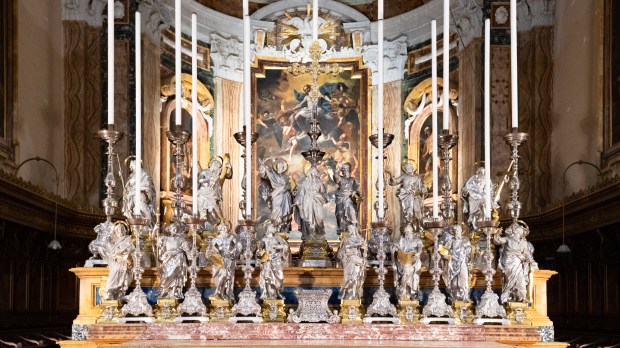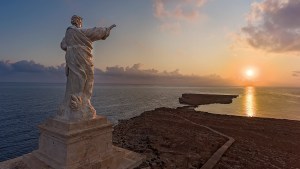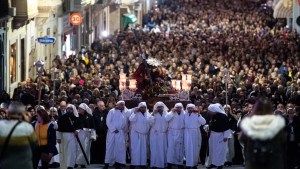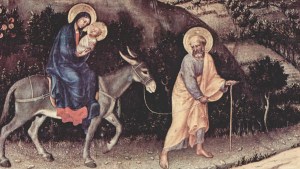The Book of Acts tells the story of how Paul was shipwrecked off the northwestern coast of Malta on his way to trial in Rome in the year 60, and spent the unnavigable winter months there. It was during those three months that he established the very roots of Maltese Christianity — Christianity in the archipelago thus being as ancient as in Ephesus, Jerusalem, Corinth, and Rome itself. However, most Christians do not immediately think of Malta as one of the early cradles of the Christian faith, despite its uninterrupted 2,000-year Christian history. The many collections of the Mdina Metropolitan Cathedral Museum are witness to this tradition.
The Mdina Metropolitan Cathedral Museum is in a magnificent Baroque building adjacent to the Cathedral. This building was to serve as the seminary for the Diocese of Malta. Bishop de Bussan and Grandmaster Manoel De Vilhena funded the building of this edifice, and the first stone was laid in 1733. The Mdina Seminary was inaugurated on the 20th May, 1742. Maltese Baroque palaces generally had a central courtyard, which allowed the halls and rooms to enjoy fresh air and sunlight all year round. The Seminary remained in Mdina until 1858, when it was relocated to Floriana. During the Crimean War, the British military used it as their headquarters, and built most of the upper floor. During the Second World War, the building was used as a boarding school. Later, the building became a retreat house and a storage facility, as well as gallery. The Cathedral Museum was established in 1897, and was opened to the public in 1969.Let’s take a look at some of its many treasures.
The Silver Statues
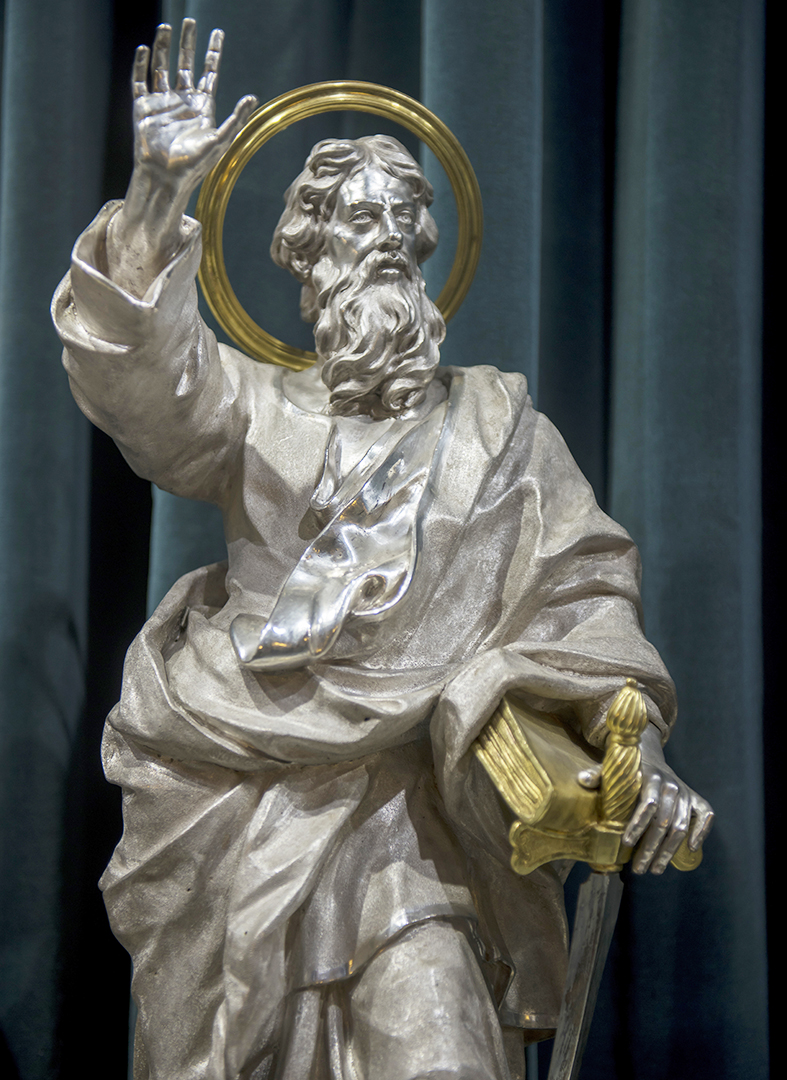
The Silver Statues are a collection of 15 silver statues dating back to 1741 – 1743, representing the Apostles, St. John the Baptist, St. Paul and the Blessed Virgin Mary. They were the work of the Roman silversmith Antonio Arrighi, and were based on those of the Lateran in Rome. The Order of St. John wanted to embellish the main altar of St. John’s Conventual Church. Today, the statues are kept in a hall known also as the Apostolato. During their occupation, between 1798 and 1800, the French confiscated silverware from churches to mint coins for their troops’ salaries. The Cathedral Chapter acted in haste and paid the French in silverware and gold the estimated value of the Statues.
On June 22, 1798, an agreement was reached, and six sealed chests containing gold and silver articles were handed to the French. The statues, however, had to be redeemed a second time. The French again demanded and got 449 pounds of silver articles, valued at 11,563 scudi, to give the statues back. The 15 priceless silver statues were studiously restored by Sante Guido Restauro e Conservazione Opere d’Art.
The Silver Collection
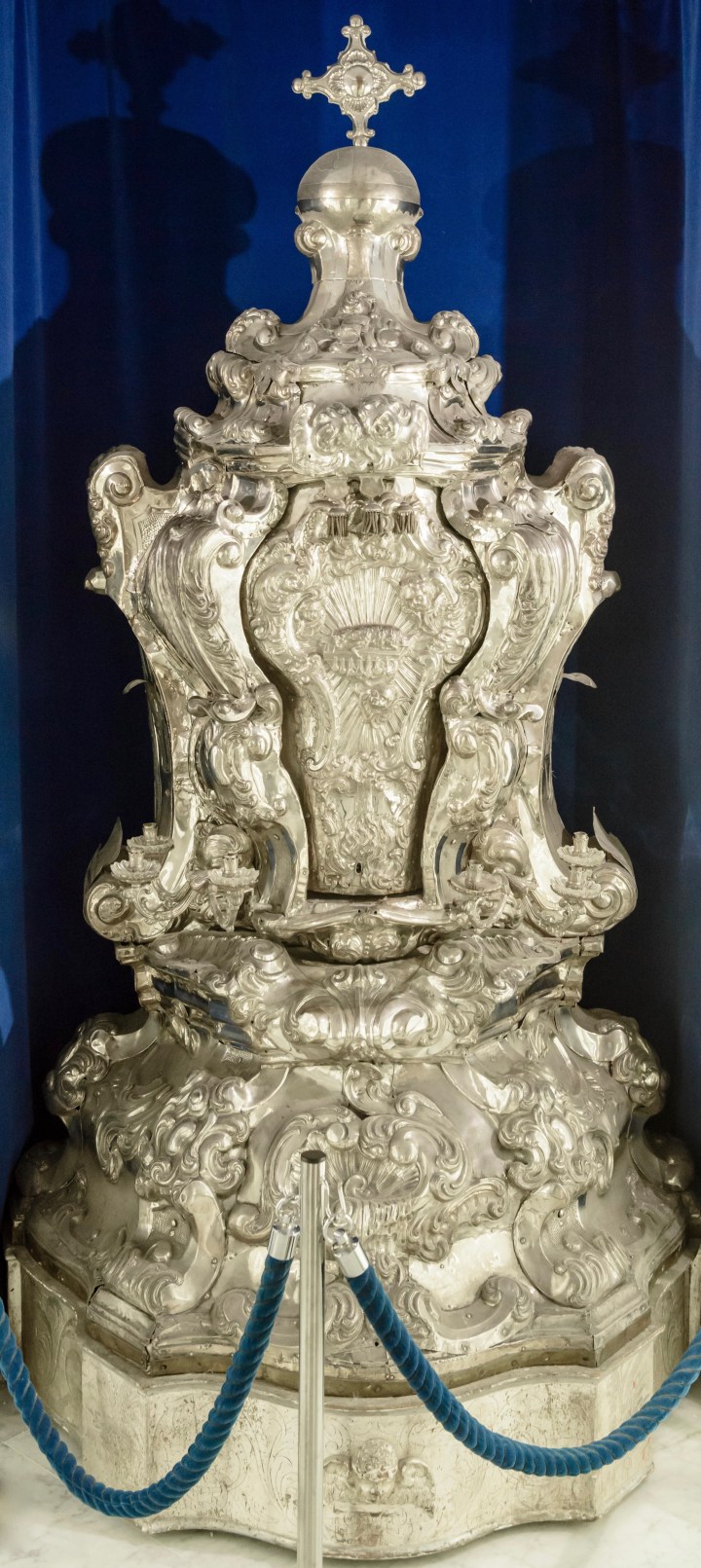
The Silver Collection consists of objects owned by the Confraternity of the Souls in Purgatory. Its members were professionals such as lawyers, architects and physicians. This was one of the wealthier brotherhoods at the time, since membership was restricted to those rich enough to pay the due. It enjoyed high prestige; one of its Rectors was Grandmaster Emanuel Pinto de Fonseca himself. In those times, confraternities were made up of lay people, who joined forces to assist the Church in her work, and followed the parish priest’s orders and directives. Indeed, it was the parish priest who passed on the request for the setting up of a confraternity to the bishop.
The Brotherhood catered for the burial of the poor and those condemned to the gallows, as well as offering assistance to the widows of the executed. The Brotherhood commissioned several pieces of fine silverware during the 17th and 18th centuries. This collection includes an image of the Madonna on a wooden pallet, which was shown to the condemned before they were hanged. All the silverware exhibited here has the emblem of the Brotherhood, a memento mori of crossbones and a skull.
The Old Mdina Cathedral Choir
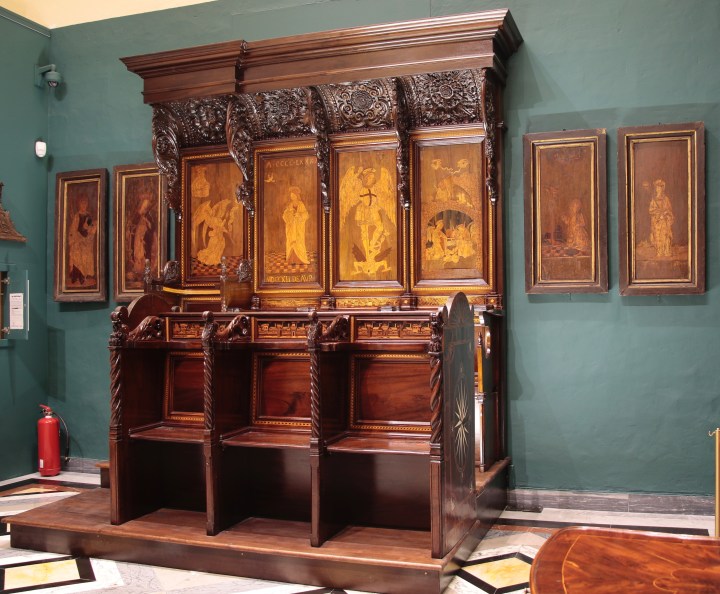
Like all other medieval cities of Western Christendom, Malta’s Civitas (Arabic Mdina) was ruled by two institutions, namely the Universitas (the city council) and the politically powerful Cathedral Chapter. Its inhabitants were generally members of the aristocratic families and cultivated burghers. As in all such cities, the two institutions were frequently at odds with each other, always jealous to defend their respective rights. In our case, both tried to project their power by showering gifts to the Cathedral Church. We can see this cultural competition unfold during the 15th century, when the Universitas donated an artistic Choir to the Cathedral. The Chapter was jealous of its rights in its own Church, but the Royal Charters gave the Universitas the final word. The question became acute when a third force entered the fray. The rising power of the Mendicant Orders became crucial to the established balance of power. The Dominican Friars were becoming more and more powerful, and when they threw their weight in the scales of the Universitas, the latter became crushingly strong. Here the origin of the stalls in the choir are an interesting case study.
In the 1480’s, the Dominicans developed an interest in the Cathedral. They knew that the Universitas were unhappy with the choir and wanted to replace it with a more prestigious one that would complement the resplendent retable (polyptych painting) of St. Paul, which it had earlier donated to the Cathedral.
However, Bishop Antonio D’Aragona objected to all this, insisting that only he could decide on such matters. The Dominican Prior Pietro Zurchi, in covert agreement with the Universitas, stepped in. He offered to donate to the Cathedral Chapter a brand-new set of stalls that he had commissioned for his Dominican Church. Zurchi was eyeing the post of Cappellano Maggiore of the Cathedral. But the office was also contested by the bishop’s nominee. The Universitas objected to the episcopal candidate because of his young age and his inability to speak Maltese. With the support of the Kingdom of the Two Sicilies and the Dominican Vicar-General, Zurchi got his appointment and the Chapter got the Choir.
Prior Zurchi was a man of refined artistic taste. In Catania he had commissioned the best woodcarvers for his choir. These were the brothers Parisio and Pierantonio Calacura, both renowned master craftsmen. The choir was finished in 1487, and brought to Malta in 1490. It remained in use until 1876 when it was replaced by the present one with wood inlays by Emmanuel Decelis, designed by Freidrich Overbeck. The Calacura Choir survived for several centuries but was subjected to many unhappy restorations. It even survived with minor damage the great earthquake of 1693. The beauty of this Choir is one of the late Gothic works of art, habitually ignored, of Maltese artistic treasure pertaining to an era before the arrival of the Order of Saint John.
The Wax Collection
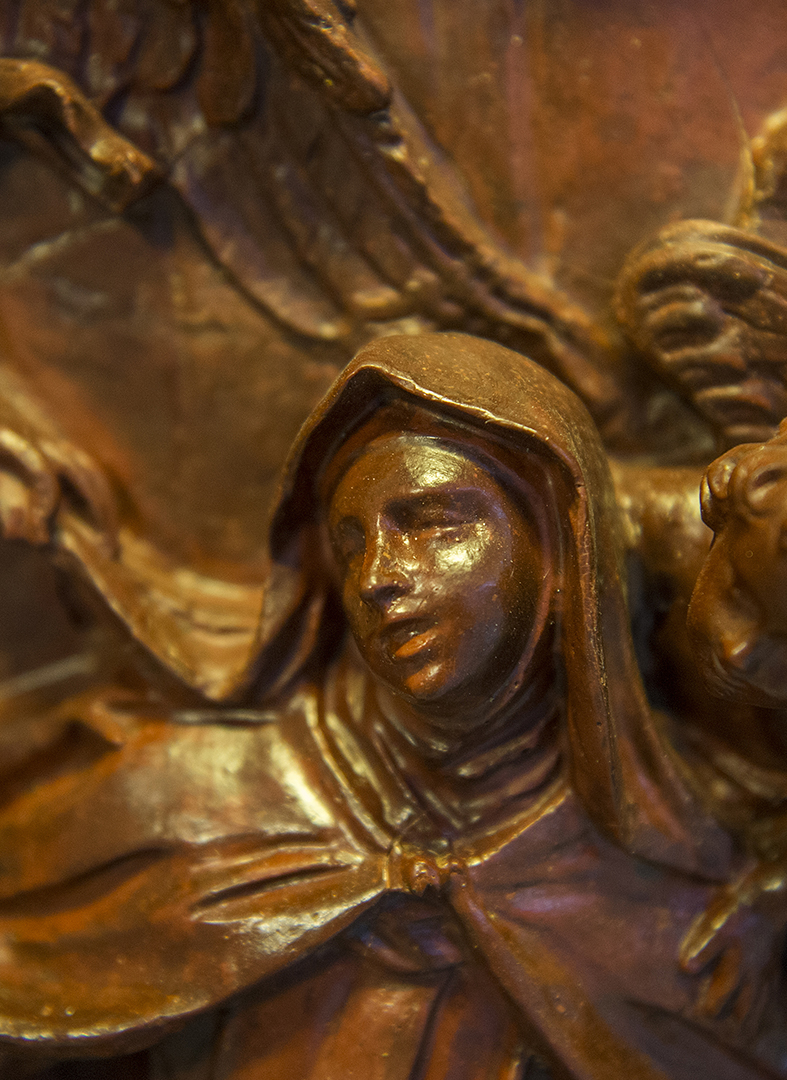
Melchiorre Cafà (1636 – 1667), a Maltese Baroque artist born in Vittoriosa, older brother of the well-known architect Lorenzo Gafa’, produced molded figures and reliefs in clay or wax to enable him to develop and shape his ideas. Among these are four bozzetti, which were produced in Rome. The wax reliefs include the Annunciation of the Blessed Virgin, the Nativity, the Adoration of the Shepherds, and the Glory of St. Rose of Lima. Research revealed that these reliefs were donated to the Mdina Cathedral prior to 1767. Until 2008, this collection was kept in the Mdina Cathedral. The works were coated with silver paint and other materials. Painstaking restoration, carried out by Sante Guido and Guiseppe Mantella, removed the silver leaf coating and the layers beneath revealing their original splendor. It is a pity that due to unprofessional restoration only 40% of the original work has survived.
The Chapel
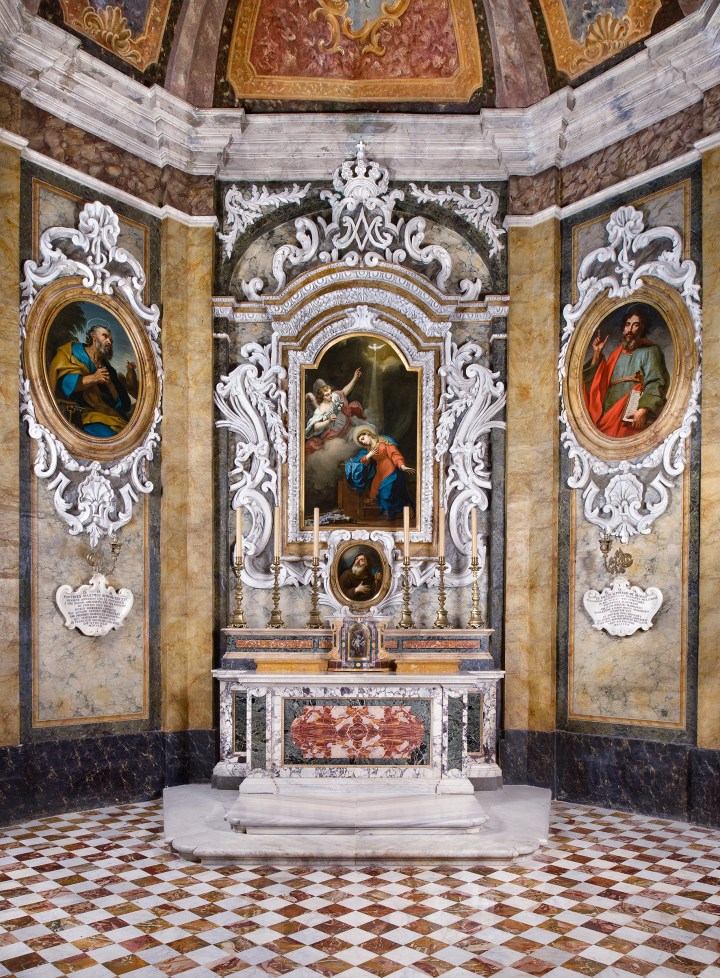
This octagonal chapel is a museum within a museum. The seminary was so dear to Bishop de Bussan that he insisted that his heart be buried in its chapel. A very curious feature of this chapel is its fake dome, composed of eight canvases onto which are painted architectural features and decorative motifs creating an illusion of a Baroque dome. The five main paintings within the chapel were commissioned by Bishop Paul Alpheran de Bussan to the court painter Antoine Favray, in 1740, the most prolific court painter in Malta of the Baroque Period. The main altarpiece shows The Annunciation, a unique and precious work of art. This painting is flanked by St. Peter and St. Paul. The other two depict St. Francis de Sales and St. Charles Borromeo. A small elliptical painting depicting St. Francis de Paola, by Francesco Zahra, is another magnificent piece.
Caravaggio and Mattia Preti’s work conditioned the character of 17th-century art in Malta, and the same happened during the second half of the 18th century with the arrival of the French painter Favray.
The Dürer Collection
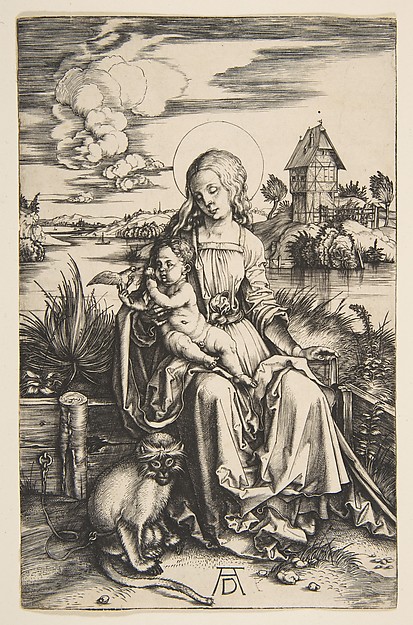
Albrecht Dürer (1471-1528) was a German painter, printmaker and theorist from Nuremberg. His prints established his reputation across Europe when he was still in his twenties. Düreris regarded the greatest artist of the German Renaissance. He regularly communicated with Raphael, Giovanni Bellini and Leonardo da Vinci, and from 1512 he was patronized by Emperor Maximilian I. His ambitious woodcuts revolutionized the potential of this medium. His well-known works include the Apocalypse, ‘Knight, Death, and the Devil,’ ‘Saint Jerome in his Study’ and ‘Melencolia I,’ which have been the subject of extensive analysis and interpretation.
He is also one of the first European landscape artists.This collection of original Dürer engravings is one of the largest outside Germany, and is comparable to the Royal Collection of Windsor Castle. It includes the whole set illustrating ‘The Life of the Virgin’ as well as the whole collection of ‘The Small Passion’ on copper plates. Other engravings are ‘St. Jerome in His Cell,’‘St. Christopher,’ and ‘The Virgin and Child with the Monkey,’ to mention a few. Four particularly interesting engravings are those of the Italian engraver and fraudist Marcantonio Raimondi, who forged Dürer’s signature.
The Halls (former dormitories of the Mdina Seminary)
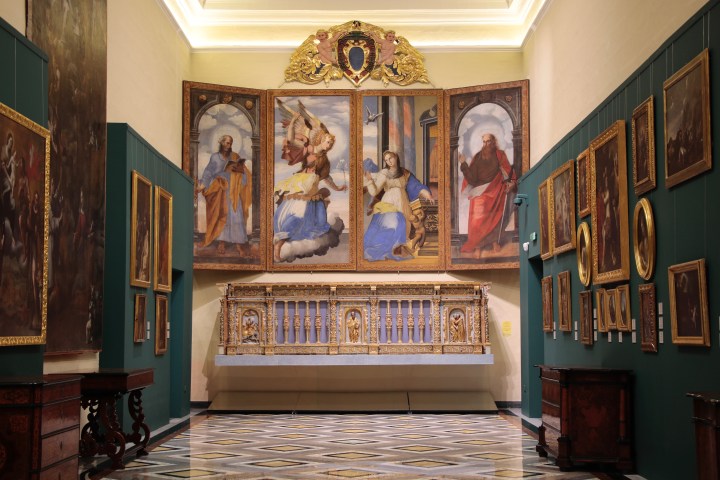
The Baroque Hall houses other paintings of the 17th and 18th centuries. One can admire a collection of paintings by artists influenced by Caravaggio. Indeed, this collection includes a signed and dated painting by Mario Minniti, a friend and student of Caravaggio, The Mocking of Christ (Ecce Homo). In this Hall one also finds works of 17th-century Italian artists. There are works by Mattia Preti and his contemporaries such as Bottega’s ‘The Annunciation,’ Pereria’s ‘The Patron Saints of the Plague,’ and Giuseppe d’Arena’s ‘St Blaise.’Opposite one finds works by Maltese 18th-century artists such as Francesco Zahra and Antoine Favre, as well as a rare painting by Giuzeppe Grech. The Baroque Hall is dominated by two impressive pieces of furniture (one of them being the medieval cathedral organ loft, which was destroyed in the great earthquake). The pieces were recently recovered, and today visitors may appreciate this magnificent work of art dating to 1601. The other piece is the aforementioned old choir stalls, brought to Malta in 1490.The balcony is complimented by the Antes. a term referring to two large paintings that used to cover the pipe organs. When opened, these two panels showed St. Peter, St. Paul and the Annunciation. After being extensively restored and placed on the balcony, the integrated parts were crowned by a lunette showing an empty coat of arms, as this used to change according to the bishop.
The Cauchi Hall
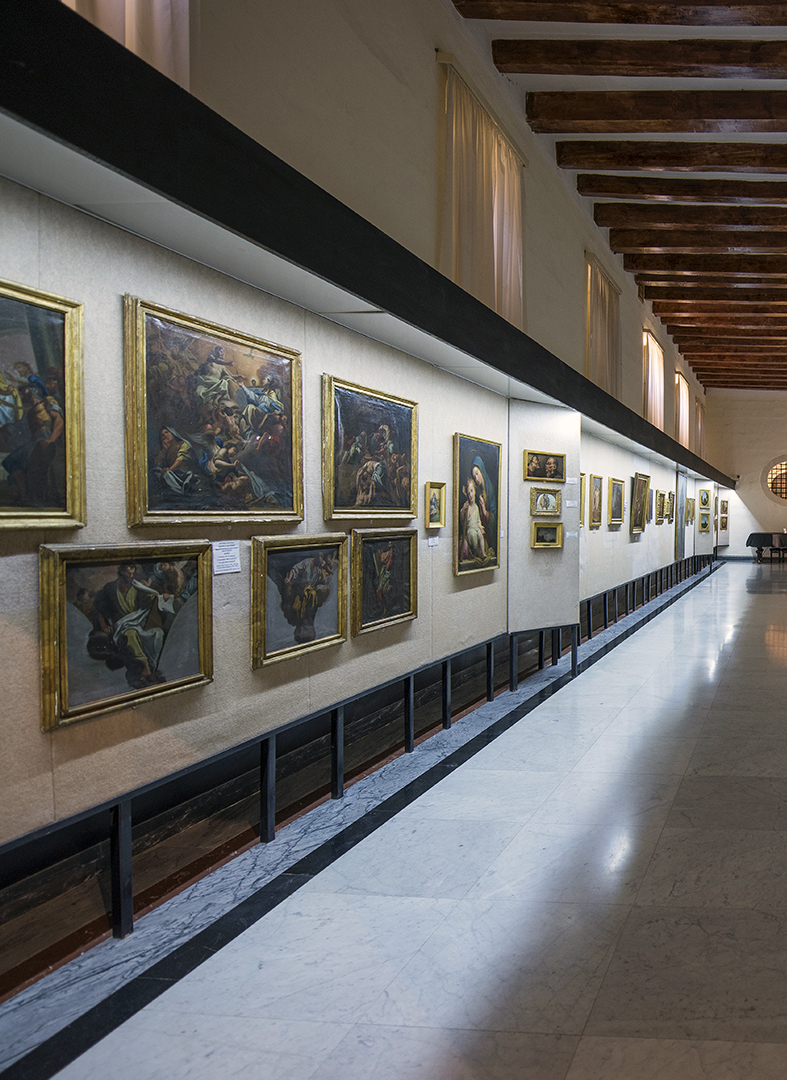
Dr. John A Cauchi donated his whole collection to the Cathedral Museum in 1994. It includes paintings, furniture and a number of Old Masters drawings. This collection is an eclectic one, showing high-quality Italian, English, French and German paintings. Dr. Cauchi was an art connoisseur who discovered, and managed to acquire, many fine pieces from auctions and market sales in England, especially after World War II. He brought them over to Malta. During the time there was the fear of taxation on properties and the arts, as well as a huge proportion of the population moving from the midlands to London to find work, resulting in works of art becoming available for purchase in different auctions and markets.
The Marchese Hall
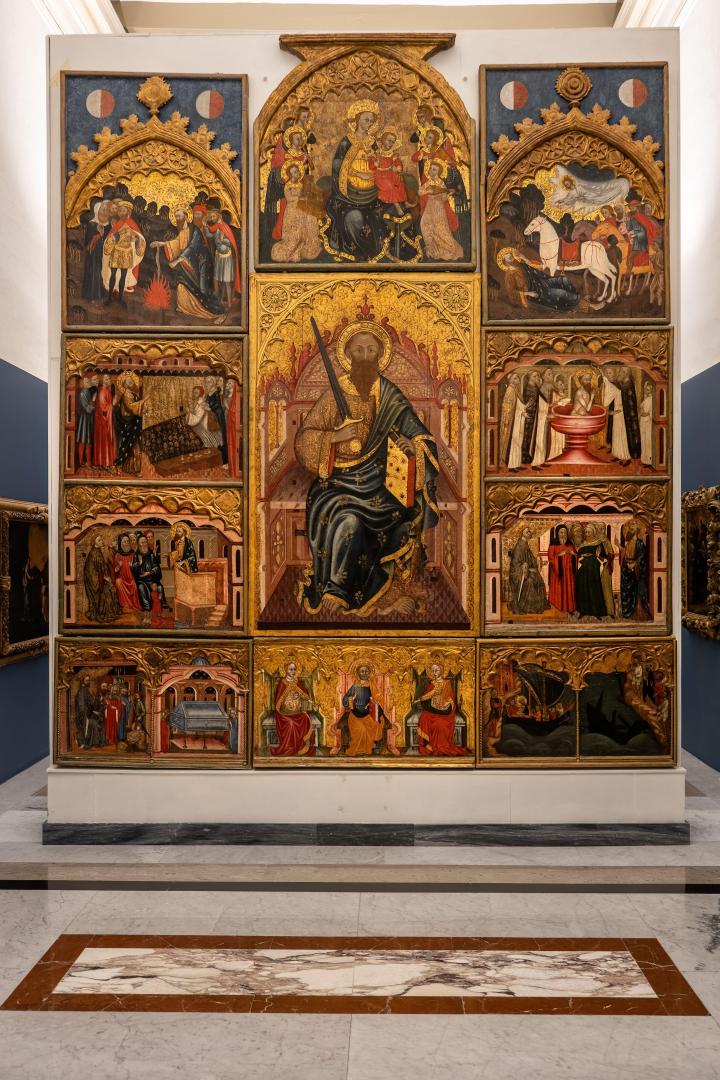
The Marchese Hall is named after Count Saverio Marchese, who donated a large collection that essentially started off the museum during the late 19th century. It included a copious number of paintings, Old Master drawings and engravings. The exhibits in this hall also include some of the most important panel paintings in Malta, dating from the 15th century. Dominating this hall is the polyptych of St. Paul. This altar painting was commissioned by the Cathedral Chapter to one of the most important art schools in Europe – Luis Borrassa of Cataluña in Spain (1360-1426). The central piece of the polyptych of St. Paul shows the enthronement of the Apostle of the Gentiles, surrounded by other panels showing various episodes of his life.
Numismatic Collection
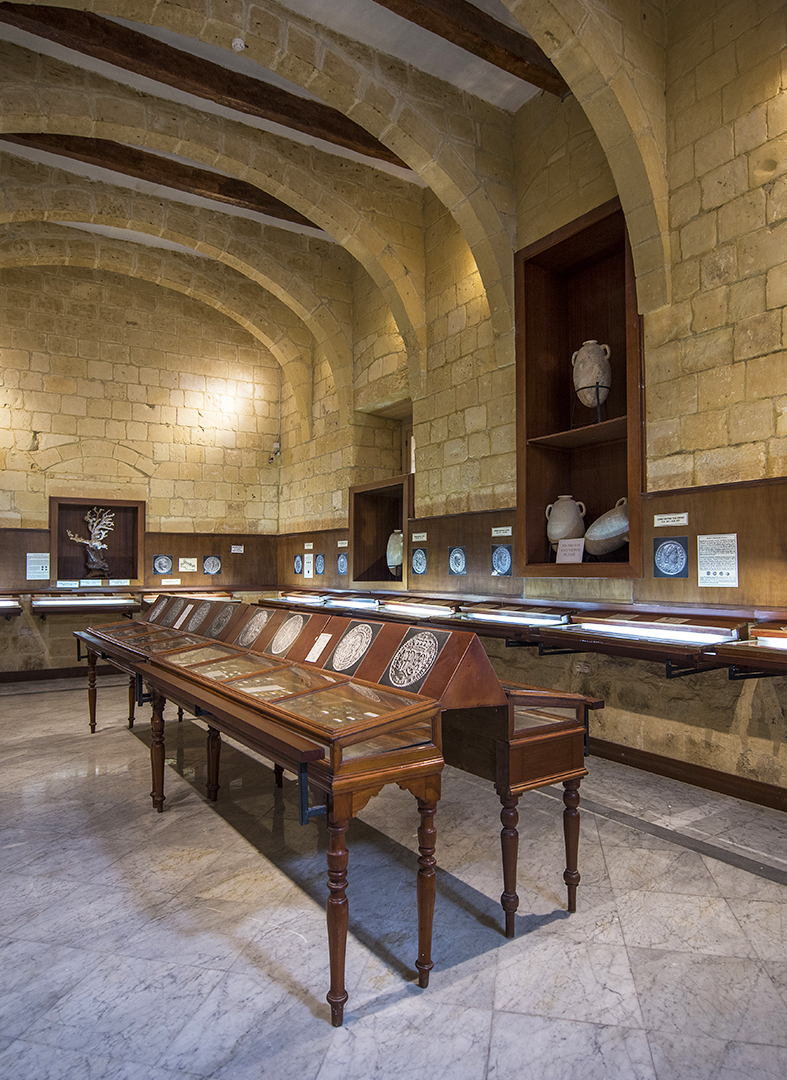
The Numismatic collection is the only major collection of coins found in Malta available for public viewing. Many of these coins are rare and historically priceless. It is arranged into four historical periods: Ancient Malta — Carthaginian, Greek, and the Romano-Maltese coinage together with the Roman coins; the medieval period — Eastern Roman, Arab, Norman, Swabian, Angevin and Aragonese/Spanish coinage; the period of rule the Military Order of St. John in Malta (1530 – 1798); and from British rule to the present day. The presentation is displayed in a chronological sequence, as follows: Carthaginian coins minted between the 4th century BC and 146 BC, Romano-Maltese coins minted in the Maltese Islands, between 212 BC and 35 BC, Republican Roman rule. A showcase displays a wide selection of Greek coins, while another displays the Hellenistic successor states that emerged after the death of Alexander the Great.
The Roman period is displayed in seven separate showcases. Nearly all the Roman emperors until 411 AD are exhibited. The medieval Malta section exhibits coinage in use during Eastern Roman rule between 533 and 870; a few from the Arab Period (871 to the arrival of Roger of Hauteville in 1091); Norman rule (1091 – 1194); the Swabian period (1194 – 1266), Angevin rule (1266 – 1282); the Aragonese (1283 – 1479); and Spanish rule (1479 – 1530). A collection of papal coins and medals is also displayed. The collection extends to coins circulating during British Colonial rule (1800 – 1964). The coins of the Republic of Malta, minted from 1971 to the present day, known as the “Central Bank Issues,” are displayed in the room leading to the Numismatic Hall.
The Jimmy Farrugia Collection
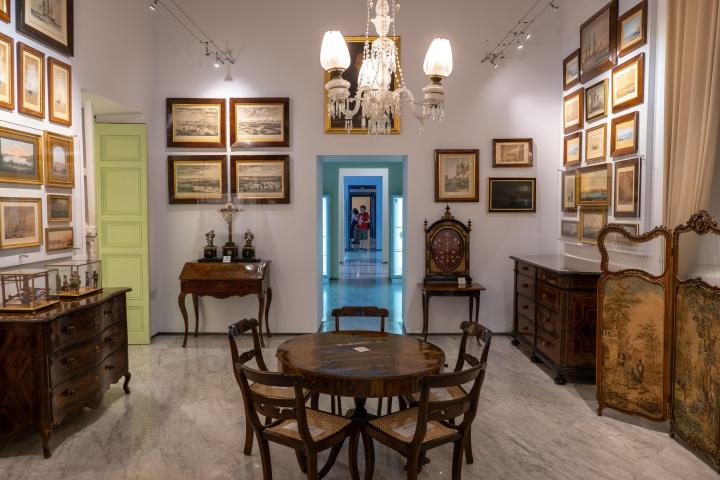
Jimmy Farrugia (1922 – 2006) was a prominent medical doctor, lay religious leader, politician and Speaker of Parliament. Subsequently, he was appointed Malta’s ambassador to the Holy See. Maltese objects d’art bequeathed by Dr. Farrugia and his wife Doris are treasured in a hall dedicated to the Melitensia collection, which includes silver artifacts, furniture, paintings, and other artistic items. Dr. Farrugia was an expert in Maltese silverware and possessed several articles. The silverware dates back to the 17th, 18th and 19th centuries, including a cruet set used by Grandmaster Manoel de Vilhena, and a silver plate bearing de Valette’s emblem. These are rare items, since most Maltese silverware was lost during the French occupation of 1798. The Farrugias also donated a collection of domestic silver.
The silverware displayed at the museum is a link between ecclesiastical items and objects related to Maltese culture. This collection also offers a repertoire of beautiful Melitensia items, such as art created by Luigi Maria Galea and Brockdorf. Furniture ranges from the 17th century through to the British Period.
The Dun Karm Room
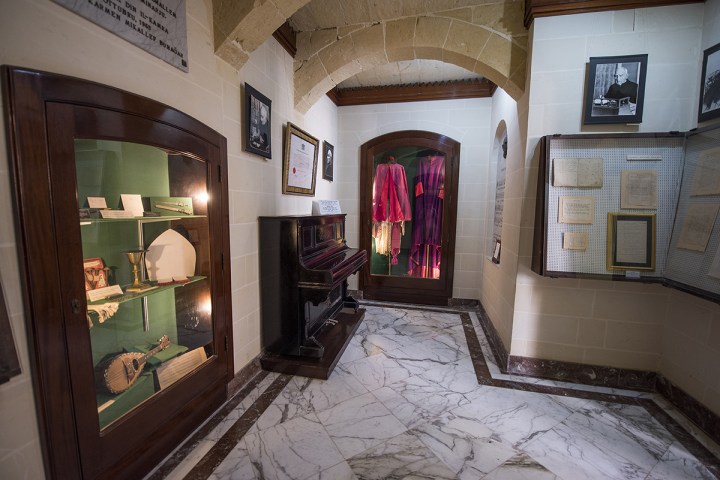
This room is dedicated to Fr. Carmelo Psaila (1871 – 1961), known as Dun Karm, the Maltese National poet. Dun Karm was also one of the founding members of the Association of Maltese Writers, and later became its president. He was also decorated by Queen Elizabeth II as Commander of the Order of the British Empire. Dun Karm often found poetic expression in his solitude, which was accompanied by a high degree of spiritual balance. The room consists of an exhibition of Dun Karm’s personal possessions, including investments, manuscripts, letters, his typewriter, as well as his piano. In 1921, Albert Laferla (at the time director of education), asked him to compose some verses to a music score by Robert Sammut. The Innu Malti, “Maltese Anthem,” which assumed the form of a prayer to God, was sung for the first time in 1923. In 1941 it was officially designated as the National Anthem, a status confirmed by the Constitution when the island was granted Independence in 1964. Following is a translation of the lyrics:
Guard her, O Lord, as ever Thou hast guarded!
This Motherland so dear whose name we bear!
Keep her in mind, whom Thou hast made so fair!
May he who rules, for wisdom be regarded!
In master mercy, strength in man increase!
Confirm us all, in unity and peace!
The Bell Room
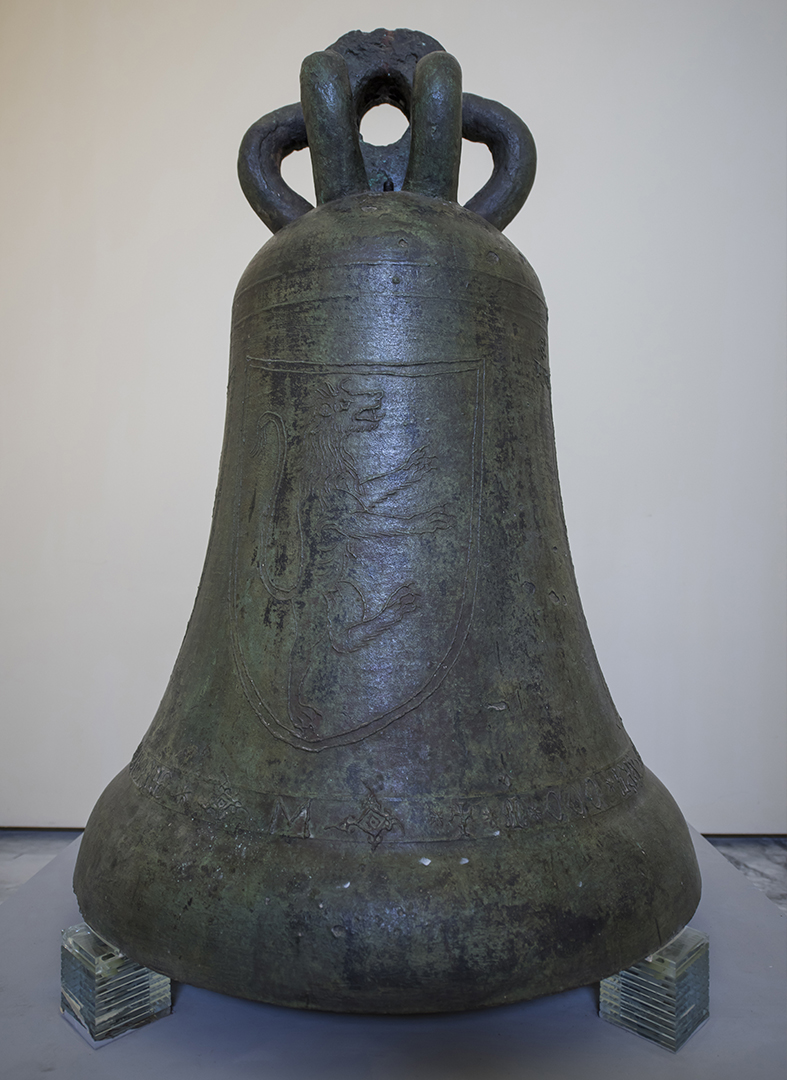
The Bell Room houses the oldest bell in Malta, which was cast by the Venetian brothers and bell-founders Nicholas and Victor. It is a unique medieval campanological specimen dating to 1370. The bell was lowered from the Cathedral belfry of the old medieval cathedral in 1645 and christened and consecrated Petronilla in honour of St. Peter on 7th August. Petronilla is one of the few mementos from the old cathedral. An effigy of St. Paul raising the sword of victory is embossed onto the Bell. The remaining sides are adorned with three armorial shields depicting a rampant lion, possibly manifesting the symbol of St. Mark the Evangelist, Patron Saint of Venice.
The date of casting, names of the founders and the matrix city are inscribed in Gothic font on the lower waist above the sound bow. During the earthquake of 1693, the old medieval cathedral suffered substantial damage and was rebuilt in Baroque style, between 1697 and 1703. The bell was reinstalled into the belfry tower and remained there until 2008, when it was removed to be restored and placed within the museum, to protect it from irreparable damage. The bell has a typical medieval musical timbre. Visitors can experience this medieval sound at the Museum, where it is digitally recorded to preserve it for posterity.
This content has been brought to you in partnership with the Malta Tourism Authority

